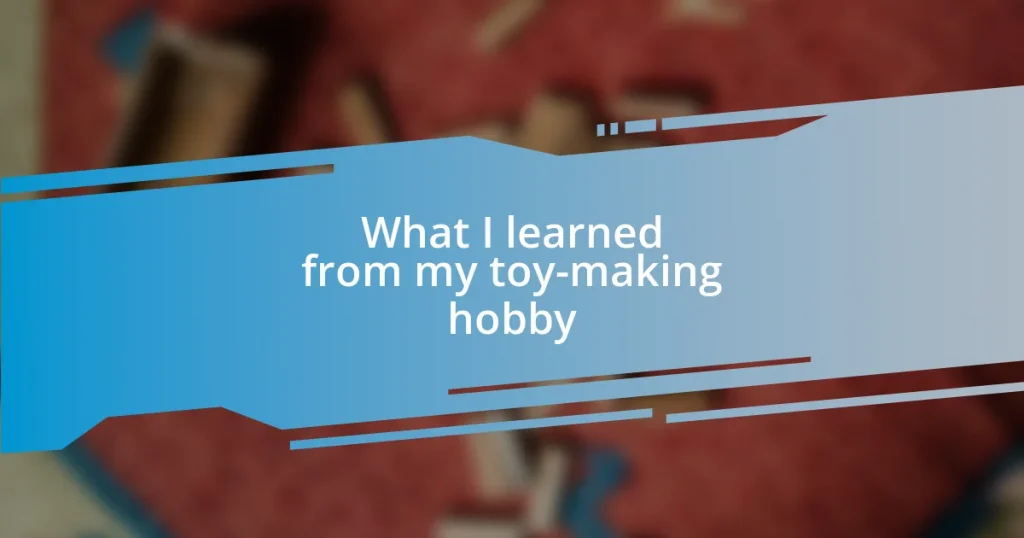Key takeaways:
- Interactive learning toys engage children through technology, fostering critical thinking, problem-solving skills, and independent exploration.
- These toys enhance intellectual, fine motor, and emotional development by providing engaging challenges and encouraging resilience in children.
- Key features for selecting toys include age appropriateness, multisensory interactions, customizable difficulty levels, and ensuring educational content for a holistic learning experience.

What are interactive learning toys
Interactive learning toys are designed to engage children in an educational yet entertaining way. They often incorporate technology—like lights, sounds, and touch sensitivity—that responds to a child’s actions. I remember watching my niece’s face light up when she pressed a button on a colorful, interactive book. It’s amazing to see how these toys motivate kids to explore and learn independently.
These toys go beyond traditional play by encouraging critical thinking and problem-solving skills. For instance, many interactive toys teach coding principles through fun, hands-on activities. How exciting is it for kids to build something and watch it come to life? I find that such experiences not only foster learning but also build confidence as they realize their capabilities.
Moreover, interactive learning toys often promote collaboration with peers and family. I’ve seen children work together to solve puzzles or respond to challenges posed by a toy, which enhances their social skills. Isn’t it wonderful to think that playtime can also be a chance for children to develop teamwork and communication? This dual benefit is what makes interactive learning toys a valuable addition to any child’s playtime experience.

Benefits of interactive learning toys
Interactive learning toys provide an enriching experience that nurtures a child’s intellectual and emotional development. For example, I remember the thrill when my young cousin managed to solve a complex maze with just a tap. The joy on his face was priceless! It’s moments like these that highlight how such toys can spark curiosity and encourage persistence in problem-solving.
Additionally, these toys can enhance fine motor skills as children manipulate various components. One time, I witnessed a group of kids constructing a robot from an interactive kit. They were not just learning about engineering principles; they were refining their dexterity in the process. Seeing their little fingers work with such focus reminded me of how play can blend learning seamlessly.
Another significant benefit is fostering emotional intelligence. Interactive learning toys often provide feedback, allowing children to experience the consequences of their actions. I vividly remember a time when my friend’s child became frustrated with a toy that didn’t do what he expected. Instead of giving up, he learned to adjust his approach, which not only taught him resilience but also provided a gentle lesson in managing emotions. It’s these life skills embedded into play that truly make interactive learning toys a treasure for childhood development.
| Benefit | Description |
|---|---|
| Intellectual Development | Encourages curiosity and critical thinking through engaging challenges. |
| Fine Motor Skills | Enhances dexterity as children manipulate toy components. |
| Emotional Intelligence | Teaches resilience and emotional management through interactive experiences. |

Key features to consider
When considering interactive learning toys, I believe it’s essential to look for engaging and adaptable features that can grow with a child. For instance, I remember purchasing an interactive tablet for my nephew that not only offered basic educational games but also had the ability to update as he progressed. Watching him explore new skills as the toy adapted to his level was both surprising and delightful. This kind of versatility keeps the learning experience fresh and exciting.
Here are some key features to consider:
- Age Appropriateness: Ensure the toy aligns with the child’s developmental stage to maximize engagement and learning.
- Multisensory Interaction: Look for toys that engage multiple senses—sight, sound, and touch—to enrich the play experience.
- Customizable Difficulty Levels: Toys that adjust their challenge based on the child’s skill level foster a sense of accomplishment without becoming too frustrating.
- Durability: Consider how well the toy is made; durability can significantly impact the longevity of the play experience.
- Educational Content: Explore whether the toy covers a range of learning topics, from STEM to language skills, to provide a holistic learning approach.
I find that the social aspect of learning toys also plays a huge role. For instance, I once joined my friends’ children in a coding game, and we ended up laughing uncontrollably as we debugged silly mistakes together. That sense of collaboration not only enhanced their learning but also created lasting memories. Ensuring that the toy invites shared experiences can turn playtime into invaluable bonding moments.

Age-appropriate recommendations
When it comes to age-appropriate recommendations, I think it’s crucial to consider the developmental milestones typical of each stage. For toddlers, simple interactive toys with large buttons and bright colors work wonders. I remember giving my niece a shape-sorting toy; the moment she fit a triangle through the right hole, her face lit up with pride. It made me realize how instrumental such toys can be in nurturing their sense of accomplishment.
As children grow into preschoolers, integrating toys that encourage imaginative play becomes vital. I once gifted a pretend kitchen set to my nephew, and it was fascinating to see him dive into role-playing, crafting his culinary masterpieces. This type of play not only sparks creativity but also develops social skills as they invite siblings or friends to join in. Have you noticed how sharing an activity can boost a child’s confidence?
For older children, I recommend interactive STEM kits that challenge their critical thinking. A while ago, I helped my cousin build a small robot from one of these kits. Working through the instructions alongside him was a reminder of how collaboration feeds curiosity and learning. I often wonder, how can we use these toys not just for fun but as gateways to deeper understanding? In my experience, the answer lies in choosing toys that expand their minds and broaden their horizons, matching the complexities of their growing interests.

Top brands in interactive toys
When it comes to top brands in interactive toys, a few stand out in my mind that consistently deliver engaging experiences. For instance, LeapFrog has been a go-to for me; their learning tablets and books have not only captured children’s attention but have also provided a solid educational foundation. I remember watching my daughter eagerly engage with their phonics games, transforming her learning into an adventure rather than a chore.
Another brand that I find incredibly appealing is VTech. They offer a wide array of toys, from interactive animals to educational laptops. One time, I had the chance to see my friend’s child use a VTech learning station, and I was amazed at how the toy sparked his curiosity. The way he interacted with the various features reminded me of how crucial it is for toys to stimulate a child’s imagination. Can you relate to that moment when a child discovers something new, and their excitement is contagious?
Lastly, Fisher-Price deserves a shout-out. Their toys, particularly the interactive ones, have a special place in my heart. I vividly recall a birthday party where a Fisher-Price smart toy captivated a group of kids, each eagerly waiting for their turn. It not only entertained them but also encouraged cooperation as they worked together to complete challenges. Isn’t it fascinating how some toys can act as a bridge for social connections? This ability to foster friendship while learning is something I truly appreciate.

Tips for effective usage
To get the most out of interactive learning toys, I recommend setting aside designated playtime. When I collaborated on a project to enhance learning with my children, we found that sticking to a consistent schedule really helped them dive deep into their toys. It’s amazing how focusing on these activities without distractions lets children fully engage and absorb new concepts.
Another effective strategy is to participate in play alongside your child. I remember sitting on the floor with my daughter as we navigated a complex puzzle together. It was satisfying to witness her excitement and determination, and engaging in her play provided opportunities to offer guidance and encouragement. This kind of shared experience not only strengthens our bond but also turns learning into a joyful adventure. Have you noticed how your input can lead to those “light bulb” moments?
Lastly, keep the learning dynamic by rotating toys to maintain interest. I’ve often shuffled the toys in our house, bringing out “forgotten gems” from the stash. It never ceases to amaze me how revitalized my kids become when they rediscover a toy they loved. This simple trick not only prevents boredom but also encourages them to explore different learning avenues. What strategies have you found useful in keeping your little ones engaged?














